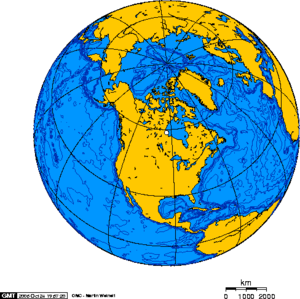Churchill, Manitoba: Difference between revisions
imported>George Swan (fix refs) |
imported>George Swan (spelling) |
||
| Line 1: | Line 1: | ||
{{subpages}} | {{subpages}} | ||
[[Image:Orthographic projection centred over Churchill, Manitoba, Canada.png|thumb|Orthographic projection centred over Churchill, Manitoba, Canada.]] | [[Image:Orthographic projection centred over Churchill, Manitoba, Canada.png|thumb|Orthographic projection centred over Churchill, Manitoba, Canada.]] | ||
'''Churchill, Manitoba''' is | '''Churchill, Manitoba''' is a small city, on the coast of [[Hudson's Bay]], in the province of [[Manitoba]], [[Canada]].<ref name=Bbc20080102> | ||
{{cite news | {{cite news | ||
| url=http://news.bbc.co.uk/2/low/business/7155494.stm | | url=http://news.bbc.co.uk/2/low/business/7155494.stm | ||
| Line 11: | Line 11: | ||
}} | }} | ||
</ref> | </ref> | ||
It lies at the mouth of [[Churchill River (Arctic)|Churchill River]], and is the [[rail-head]] of a rail-link to [[North American rail grid]]. | It lies at the mouth of the [[Churchill River (Arctic)|Churchill River]], and is the [[rail-head]] of a rail-link to the [[North American rail grid]]. | ||
It is Canada's only seaport on the [[Arctic Ocean]].<ref name=Bbc20080102/> | It is Canada's only seaport on the [[Arctic Ocean]].<ref name=Bbc20080102/> | ||
It is [[North America]]'s only Arctic seaport that is connected to the North American [[railroad]] grid. | It is [[North America]]'s only Arctic seaport that is connected to the North American [[railroad]] grid. | ||
It is ice-bound | It is ice-bound from December to June.<ref name=NYTimes2005-10-10> | ||
{{cite news | |||
| url = https://www.nytimes.com/2005/10/10/science/10arctic.html?pagewanted=all | |||
| title = As Polar Ice Turns to Water, Dreams of Treasure Abound | |||
| publisher = [[New York Times]] | |||
| author = Clifford Krauss, Steven Lee Myers, Andrew C. Revkin, Simon Romero | |||
| date = 2005-10-10 | |||
| archivedate = 2012-07-16 | |||
| archiveurl = http://www.webcitation.org/query?url=https%3A%2F%2Fwww.nytimes.com%2F2005%2F10%2F10%2Fscience%2F10arctic.html%3Fpagewanted%3Dall&date=2012-07-16 | |||
| dead = no | |||
| quote = | |||
}} | |||
[http://www.webcitation.org/query?url=https%3A%2F%2Fwww.nytimes.com%2F2005%2F10%2F10%2Fscience%2F10arctic.html%3Fpagewanted%3Dall&date=2012-07-16 mirror] | |||
</ref> | |||
But it is ice-free in time for the annual wheat harvest. Shipping wheat is cheaper by sea, than by rail. It is cheaper to transport grain to Churchill by rail, and then transship it to bulk carriers to take to Europe than it is to transport it by rail to an East Coast port, and transfer it to a bulk carrier to the trip to Europe there.. | |||
With [[global warming]] there is speculation that it may become economic to ship other goods from [[Murmansk]] around the Southern tip of Greenland, to Churchill, and then by rail to markets in North America.<ref name=Bbc20080102/> | With [[global warming]] there is speculation that it may become economic to ship other goods from [[Murmansk]] around the Southern tip of Greenland, to Churchill, and then by rail to markets in North America.<ref name=Bbc20080102/> | ||
| Line 48: | Line 62: | ||
</ref> | </ref> | ||
The port has four berths capable of handling deep-sea [[panamax]] vessels. | The port has four berths capable of handling deep-sea [[panamax]] vessels. | ||
The port is open from July through November.<ref name=NYTimes2005-10-10 | The port is open from July through November.<ref name=NYTimes2005-10-10/> | ||
==References== | ==References== | ||
<references/> | <references/> | ||
Revision as of 00:43, 16 July 2012
Churchill, Manitoba is a small city, on the coast of Hudson's Bay, in the province of Manitoba, Canada.[1] It lies at the mouth of the Churchill River, and is the rail-head of a rail-link to the North American rail grid.
It is Canada's only seaport on the Arctic Ocean.[1] It is North America's only Arctic seaport that is connected to the North American railroad grid. It is ice-bound from December to June.[2] But it is ice-free in time for the annual wheat harvest. Shipping wheat is cheaper by sea, than by rail. It is cheaper to transport grain to Churchill by rail, and then transship it to bulk carriers to take to Europe than it is to transport it by rail to an East Coast port, and transfer it to a bulk carrier to the trip to Europe there..
With global warming there is speculation that it may become economic to ship other goods from Murmansk around the Southern tip of Greenland, to Churchill, and then by rail to markets in North America.[1] This route is sometimes referred to as the "Arctic Bridge".
In 1998 the aging and under-used port facilities, and tracks from Churchill to Winnipeg were bought by an American firm named Omnitrax, for just $10.[1]
Port facilities were opened in 1932.[3] Grain shipments compose ninety percent of the cargo transiting the port.[4] The port has four berths capable of handling deep-sea panamax vessels. The port is open from July through November.[2]
References
- ↑ 1.0 1.1 1.2 1.3 Canada's climate change boomtown, BBC, 2008-01-02. Retrieved on 2008-08-10.
- ↑ 2.0 2.1 Clifford Krauss, Steven Lee Myers, Andrew C. Revkin, Simon Romero. As Polar Ice Turns to Water, Dreams of Treasure Abound, New York Times, 2005-10-10. mirror
- ↑ Bring General Cargo from European Ports To Churchill In July, Saskatoon Star-Phoenix, 1932-06-03, p. 5. Retrieved on 2010-10-.
- ↑ Transportation: Seaport at Churchill, Manitoba, Government of Manitoba. Retrieved on 2012-07-15.
